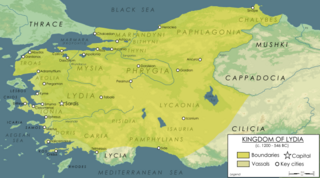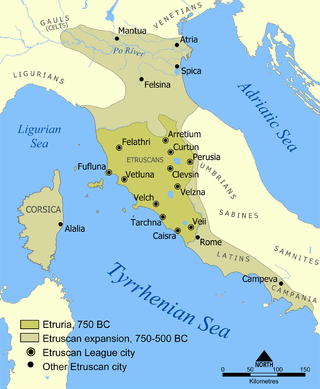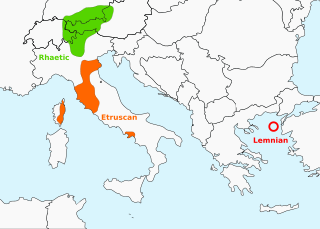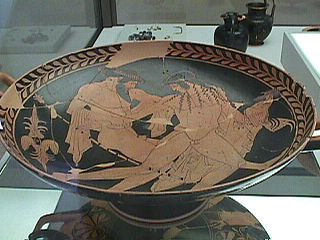Related Research Articles

Etruscan was the language of the Etruscan civilization in the ancient region of Etruria, in Etruria Padana and Etruria Campana in what is now Italy. Etruscan influenced Latin but was eventually completely superseded by it. The Etruscans left around 13,000 inscriptions that have been found so far, only a small minority of which are of significant length; some bilingual inscriptions with texts also in Latin, Greek, or Phoenician; and a few dozen purported loanwords. Attested from 700 BC to AD 50, the relation of Etruscan to other languages has been a source of long-running speculation and study, with it mostly being referred to as one of the Tyrsenian languages, at times as an isolate and a number of other less well-known theories.

Lydia was an Iron Age kingdom situated in the west of Asia Minor, in modern-day Turkey. The ethnic group inhabiting this kingdom are known as the Lydians, and their language as Lydian and their capital was Sardis.

Minerva is the Roman goddess of wisdom, justice, law, victory, and the sponsor of arts, trade, and strategy. Minerva is not a patron of violence such as Mars, but of strategic war. From the second century BC onward, the Romans equated her with the Greek goddess Athena. Minerva is one of the three Roman deities in the Capitoline Triad, along with Jupiter and Juno.

The Etruscan civilization was an ancient civilization created by the Etruscans, a people who inhabited Etruria in ancient Italy, with a common language and culture who formed a federation of city-states. After conquering adjacent lands, its territory covered, at its greatest extent, roughly what is now Tuscany, western Umbria, and northern Lazio, as well as what are now the Po Valley, Emilia-Romagna, south-eastern Lombardy, southern Veneto, and western Campania.

Etruscan religion comprises a set of stories, beliefs, and religious practices of the Etruscan civilization, heavily influenced by the mythology of ancient Greece, and sharing similarities with concurrent Roman mythology and religion. As the Etruscan civilization was gradually assimilated into the Roman Republic from the 4th century BC, the Etruscan religion and mythology were partially incorporated into ancient Roman culture, following the Roman tendency to absorb some of the local gods and customs of conquered lands. The first attestations of an Etruscan religion can be traced back to the Villanovan culture.
In Etruscan religion, Fufluns or Puphluns was a god of plant life, happiness, wine, health, and growth in all things. He is mentioned twice among the gods listed in the inscriptions of the Liver of Piacenza, being listed among the 16 gods that rule the Etruscan astrological houses. He is the 9th of those 16 gods. He is the son of Semla and the god Tinia. He was worshipped at Populonia and is the namesake of that town.

In Etruscan Religion and mythology, Thesan is the Etruscan goddess of the dawn, divination, and childbirth and was associated with the generation of life. Romans identified her with their Aurora and Mater Matuta and Greeks with Eos and Leucothea. In Etruria, she received offerings together with the sun god Usil in the liber linteus. She was especially worshipped at Caere's harbour of Pyrgi, where a temple was dedicated to her and a singular series of ‘‘daybreak antefixes’’ was excavated.

In Etruscan religion, Hercle, the son of Tinia and Uni, was a version of the Greek Heracles, depicted as a muscular figure often carrying a club and wearing a lionskin. He is a popular subject in Etruscan art, particularly bronze mirrors, which show him engaged in adventures not known from the Greek myths of Heracles or the Roman and later classical myths of Hercules.

Tyrrhenians or Tyrsenians was the name used by the ancient Greeks authors to refer, in a generic sense, to non-Greek people, in particular pirates.

Spina was an Etruscan port city, established by the end of the 6th century BCE, on the Adriatic at the ancient mouth of the Po.

Uni is the ancient goddess of marriage, fertility, family, and women in Etruscan religion and myth, and was the patron goddess of Perugia. She is identified as the Etruscan equivalent of Juno in Roman mythology, and Hera in Greek mythology. As the supreme goddess of the Etruscan pantheon, she is part of the Etruscan trinity, an original precursor to the Capitoline Triad, made up of her husband Tinia, the god of the sky, and daughter Menrva, the goddess of wisdom.

Caere is the Latin name given by the Romans to one of the larger cities of southern Etruria, the modern Cerveteri, approximately 50–60 kilometres north-northwest of Rome. To the Etruscans it was known as Cisra, to the Greeks as Agylla and to the Phoenicians as 𐤊𐤉𐤔𐤓𐤉𐤀.
Venus is the name of two fictional characters appearing in American comic books published by Marvel Comics. The first, originally based on the goddess Venus (Aphrodite) from Roman and Greek mythology, was retconned to actually be a siren that only resembles the goddess. The second is stated to be the true goddess, who now wishes only to be referred to by her Greek name, Aphrodite. The similarities between the two characters are a point of conflict in the comics.

Hercules is a character appearing in American comic books published by Marvel Comics. Debuting in the Silver Age of Comic Books, the character is based on Heracles of Greek mythology. Since his first appearance, he has been a perennial member of the superhero team the Avengers.
The Trojan language was the language spoken in Troy during the Late Bronze Age. The identity of the language is unknown, and it is not certain that there was one single language used in the city at the time.

Neptune, also called Poseidon, is a fictional character appearing in American comic books published by Marvel Comics. The character is based on the Roman God with the same name and his Greek counterpart. Neptune is the god of the sea in the Olympian pantheon, and the patron god of Atlantis. Neptune first appeared in Tales to Astonish #70 and was adapted by Stan Lee and Gene Colan.

Etruscan art was produced by the Etruscan civilization in central Italy between the 10th and 1st centuries BC. From around 750 BC it was heavily influenced by Greek art, which was imported by the Etruscans, but always retained distinct characteristics. Particularly strong in this tradition were figurative sculpture in terracotta, wall-painting and metalworking especially in bronze. Jewellery and engraved gems of high quality were produced.

Usil is the Etruscan god of the sun, shown to be identified with Apulu (Apollo). His iconic depiction features Usil rising out of the sea, with a fireball in either outstretched hand, on an engraved Etruscan bronze mirror in late Archaic style, formerly on the Roman antiquities market. On Etruscan mirrors in the Classical style, Usil appears with an aureole.

The mythologies in present-day Italy encompass the mythology of the Romans, Etruscans, and other peoples living in Italy, those ancient stories about divine or heroic beings that these particular cultures believed to be true and that often use supernatural events or characters to explain the nature of the universe and humanity.
Śuri, later Latinized as Soranus, was an ancient Etruscan deity, also venerated by other populations of central Italy and later adopted into ancient Roman religion.
References
- ↑ As Artimi, see Denise Demetriou, Negotiating Identity in the Ancient Mediterranean: The Archaic and Classical Greek Multiethnic Emporia (Cambridge University Press, 2012), 70. ISBN 9781316347898 books.google.com/books?id=p0qwCgAAQBAJ&pg=PA70 And Thomson de Grummond, Nancy (2006). Etruscan Myth, Sacred History, and Legend. University of Pennsylvania Museum of Archaeology and Anthropology. pp. 12, 51, 99–103, 130–32, 141, 149, 158. ISBN 978-1-931707-86-2. Referred to as "Artumes".
- ↑ Pittau, Massimo (2006). Toponimi Italiani di origine Etrusca. (Sassari, Magnum Edizioni). Referenced in English on the Aritimi-Rezzo connection in Flavio Carnevale and Marcello Ranieri, "Lunistices at Sesto Fiorentino: An Investigation on Geometry and Alignments of the Tholos Tombs of the Etruscan Princes", Mediterranean Archaeology and Archaeometry 16/4 (2016), 224. Online at http://maajournal.com/Issues/2016/Vol16-4/Full31.pdf
- ↑ Van Lente, Fred; Pak, Greg; et al. (December 31, 2008). "Incredible Hercules #124". Marvel Universe. Retrieved 26 April 2010.
